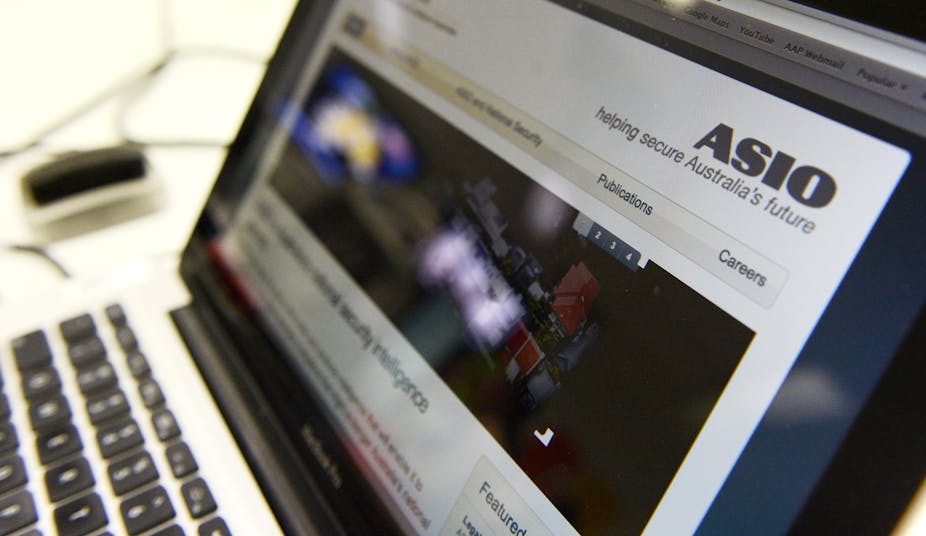Frank Moorhouse is known primarily – but not exclusively – for his award-winning fiction such as the Edith Triology. In more recent times, he has turned his considerable talents to the role of the Australian Security Intelligence Organisation (ASIO) in Australian society in a series of essays.
That research has now spawned a book, Australians Under Surveillance. It is the latest contribution in a field of renewed interest. Debates regarding ASIO have existed since its inception under the Chifley government in 1949.
Today, these debates take two forms. First is the debate about what Moorhouse terms the “legacy” question – the historical role of ASIO, particularly during the Cold War. The second is the questions regarding the powers ASIO should (or shouldn’t) have in what Moorhouse has previously termed a “time of terror”.
Moorhouse begins his latest offering by discussing his own history with ASIO. As a young writer with anarchist tendencies, Moorhouse was a subject of ASIO surveillance. He details the history of ASIO in the surveillance of Australian writers in a Cold War climate which included political attacks on recipients of grants from the Commonwealth Literary Fund by Australia’s would-be McCarthys.
These attacks were often misguided. The vehement anti-communist W. C. Wentworth, for example, was forced into making a humiliating apology to author Kylie Tennant. Moorhouse’s focus is initially on writers. As such, he does not deal with similar attacks, often based on information from ASIO provided improperly to Wentworth and others, on other professions such as scientists and the public service. These also formed part of the Cold War climate which he describes. His discussion of sexual censorship is also illuminating.
The argument quickly moves on to controversial contemporary cases involving Mohamed Haneef and Izhar Ul-Haque. Moorhouse realises – to his credit – that the value of comparison between ASIO’s Cold War legacy and ASIO today is limited:
With communism and sexual issues there was no imminent threat of violence in Australia; with terrorism there is the possibility of a very real threat.
This is a salient point. The reason for ASIO’s existence was to prevent espionage rather than an Australian Bolshevik revolution. Moorhouse’s interview with former ASIO Director-General David Irvine reveals the security service’s current priorities. Irvine says:
My concern is a bombing incident or something that causes mass casualties.
In both areas, however, the debate has moved forward even in the short time since the release of Moorhouse’s book. An official history of ASIO by David Horner, covering the period 1949 to 1963, has also been released, shedding light on ASIO’s Cold War legacy. ASIO’s role in fighting terrorism today has also been highlighted by the tragic events of the Martin Place siege in December 2014.

The value of Moorhouse’s argument lies in his nuanced understanding of ASIO’s role. He accepts the necessity of ASIO’s existence, recognises that terrorism is a significant threat, and at times seems to proffer advice on how to address the historical problems of ASIO’s public image. He cites comments which suggest that ASIO has never enjoyed the public support of its foreign counterparts MI5 or the FBI.
This recognition of ASIO’s importance sets Moorhouse apart from those who are unquestioningly critical of the organisation, including those who have called for its abolition. His “dark conundrum” concerns itself with how such an agency behaves (and is overseen) in a liberal democratic society when the performance of its duties inevitably involves depriving citizens of some of that liberty.
Nevertheless, Moorhouse raises significant and concerning questions about the conduct of an organisation with increasing powers and little oversight. In Australia, the Inspector-General of Intelligence and Security has the responsibility for watching over ASIO (and five other agencies). The IGIS, however, employs an ongoing staff of just 12 to watch over an increasingly large national security apparatus.
Moorhouse’s catalogue of cases where he contends rights were infringed or due process ignored is where the links between ASIO in the Cold War and ASIO today can be drawn out by implication. He hints that various raids, computer “cleansing” (the deletion of material by ASIO on computers, including those of publishers and a university professor), legal threats, deportations, media controversies and censorship of literature are intimidatory and contribute to an environment where certain thoughts are seen as dangerous, leading to voluntary self-censorship and the suppression of ideas.
Just as McCarthyism swept up other causes which were not necessarily communist – such as anti-war protests, trade unions, nuclear disarmament and civil rights for Aboriginals and Torres Strait Islanders – so too the current climate threatens legitimate dissent. This can include, for example, opposition to wars in Afghanistan and Iraq, advocacy for asylum seekers, questioning of ASIO’s powers and, potentially, campaigns against Islamophobia. It also places suspicion on the wider Australian Muslim community.
Moorhouse calls for a new compact between ASIO and Australian society. In doing so, he explores issues of privacy, freedom of expression, censorship and what he terms “civic dignity”. It is at once respectful of ASIO’s successes and critical of its transgressions. He describes ASIO as:
… sometimes getting it wrong with potentially disastrous effects, and sometimes saving Australian lives.
Australians Under Surveillance deserves to be widely read, and its ideas carefully considered.

